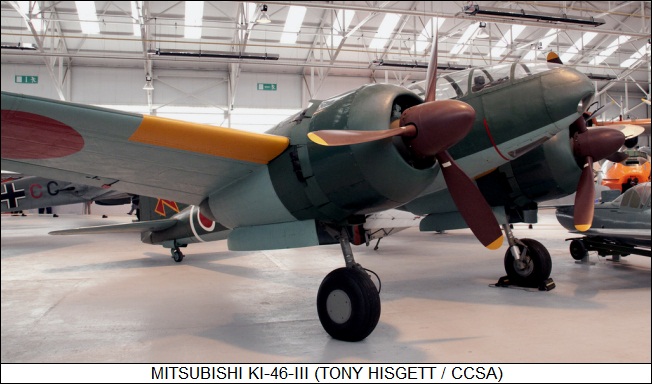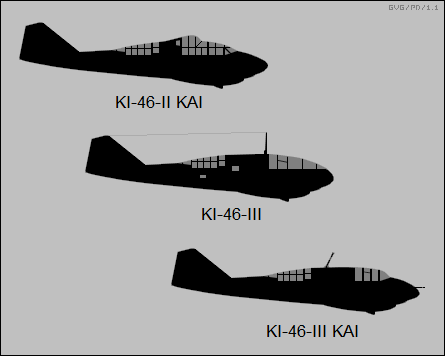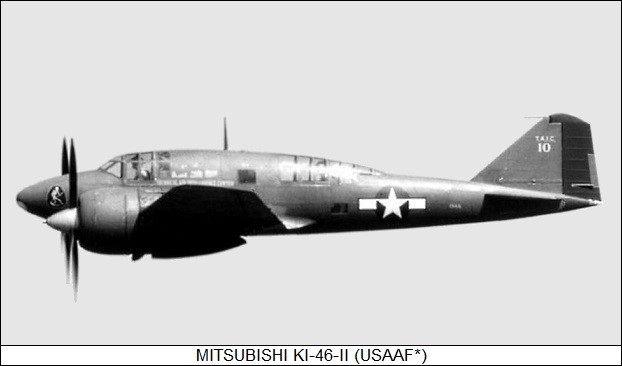
* The Mitsubishi Ki-46 was one of the most impressive aircraft flown by the Japanese during World War II. The Ki-46 served with distinction from the beginning to the end of the war in the Pacific. This document provides a history and description of the Ki-46.

* In 1937, the Japanese firm of Mitsubishi Heavy Industries Company delivered a new reconnaissance aircraft, the "Ki-15", to the Imperial Japanese Army (IJA). The Ki-15 was a clean, single-seat, single-engine monoplane with fixed landing gear and excellent range, and though it appeared useful enough for the moment, the Technical Branch of the Imperial Army Air Headquarters (Koku Hombu) knew that other nations were developing fighters fast enough to overtake and destroy it.
Within two months of the first service delivery of the Ki-15, the Koku Hombu began work on the specifications for its successor, an improved reconnaissance aircraft that was to discreetly overfly lands belonging to Japan's potential adversaries. The requirements that were defined by the Koku Hombu's Major Fujita Yuzo and his staff were aggressive, dictating an aircraft with a top speed of 600 KPH (373 MPH) at 4,000 meters (13,100 feet). This was much faster than any Japanese aircraft that had flown to that time.
The new aircraft also was to have an endurance of six hours at 400 KPH (250 MPH) at an altitude of 4,000 to 6,000 meters (13,100 to 19,700 feet). The IJA air staff knew that building an aircraft with such capabilities would not be easy, and so gave industry designers a generally free hand in designing whatever they thought could do the job. The aircraft could have one or two engines, using air-cooled radials in the 560 to 710 kW (750 to 950 HP) class, such as the Nakajima Ha-20-Otsu, Nakajima Ha-25, or Mitsubishi Ha-26.
* Mitsubishi was already designing a fast twin-engined reconnaissance aircraft designated the "Ki-40", a variant of the company's proposed Ki-39 twin-engine fighter. Since Mitsubishi's aircraft already had a good reputation with the military, Mitsubishi was awarded the contract for the new reconnaissance aircraft by the Koku Hombu on 12 December 1937.
Although the Ki-40 hadn't been flown by that time, the Mitsubishi design team, led by Kubo Tomio and Hattori Joji, realized very quickly that there was no way it could be fast enough to meet the Koku Hombu specification. They junked the Ki-40 design, retaining only some of its features in a new, much more streamlined and elegant twin-engine aircraft with low-mounted thin wings.
The new design was given the designation "Ki-46". It featured a forward crew compartment for the pilot and a separate crew compartment facing the rear for the radio operator, with the two compartments separated by a bay containing cameras and a large fuel tank with a capacity of 1,660 liters (440 US gallons). The unusual crew accommodations were dictated by the need to put the big fuel tank at the center of gravity. It had taildragger landing gear, with a retractable tailwheel and the main gear retracting back into the engine nacelles.
The twin powerplants were Mitsubishi Ha-26 14-cylinder two-row air-cooled radial engines with single-speed superchargers, with each engine providing 746 kW (900 HP). The Nakajima Ha-25 radial was lighter and more powerful, but Mitsubishi preferred to supply their own engines.
The Mitsubishi design team had worked with the Aeronautical Research Institute of the University of Tokyo to perform wind-tunnel tests for streamlining the aircraft and in particular to optimize the engine fit, coming up with aerodynamic, close-fitting cowlings and large spinners fitted over the three-bladed constant-speed variable-pitch propellers. The tight cowlings also improved the pilot's field of view.
* Despite such efforts, when flight trials began in 1939 with Major Fujita at the controls, the Ki-46 did not meet the speed requirements requested by the Koku Hombu, attaining only 540 KPH (335 MPH) at 4,000 meters (13,100 feet). The Koku Hombu still found it an excellent aircraft in all other regards, and so the Ki-46 was accepted for production as the "Army Type 100 Command Reconnaissance Aircraft Model 1 (Ki-46-I)". The Koku Hombu did specify that Mitsubishi was to immediately begin work on a faster version, the "Ki-46-II". Since the Ki-46-I's relatively low performance meant that it was in principle vulnerable to interception, the back-seat position was fitted with a single moveable Type 89 7.7-millimeter (0.303-caliber) machine gun to provide a minimal self-defense capability.
At the time, Mitsubishi was heavily committed to building other aircraft, and production of the Ki-46-I was slow. Manufacturing problems were aggravated by the fact that the Ki-46 had been designed for high performance at the expense of ease of manufacture and maintenance. A few were delivered for IJA evaluation during the spring of 1940, and in a short time a number of them were provided to the Shimoshizu Rikugun Hikogakuko (Shimoshizu Army Flying School) for crew training.
By the spring of 1941, the IJA had at least 386 Ki-46s on order, but they were still only being delivered at the rate of four a month. Mitsubishi was ordered to stop production of some older aircraft and shift resources to building the Ki-46, and by November 1941 deliveries had reached ten aircraft a month. Monthly production would continue to increase, to a peak of 75 aircraft delivered in March 1944.
BACK_TO_TOP* While Mitsubishi manufacturing engineers were scrambling to increase Ki-46 production, the company's research and development engineers were just as busy working to get the aircraft's performance up to IJA requirements. To this end, they modified the Ha-26 radial engine by adding a two-speed supercharger, resulting in the Ha-102 radial, with 805 kW (1,080 HP) at takeoff and 790 kW (1,055 HP) at 2,800 meters (9,200 feet). The form factor of the Ha-102 was close enough to that of the Ha-26 to allow the new engine to fit into the Ki-46-I's carefully-tailored cowlings without any modifications.

The first Ki-46-II powered by the new engines took to the air in March 1941 and slightly exceeded Koku Hombu speed requirements, reaching a top speed of 604 KPH (375 MPH) at 5,800 meters (19,000 feet). With the Koku Hombu's faith in Mitsubishi vindicated and with new Ki-46-IIs beginning to flow out of production by the middle of 1941, the IJA was able to begin forming operational reconnaissance units.
___________________________________________________________________
MITSUBISHI KI-46-II:
___________________________________________________________________
wingspan:
14.7 meters (48 feet 2 inches)
wing area:
32 sq_meters (344.5 sq_feet)
length:
11.0 meters (36 feet 1 inch)
height:
3.88 meters (12 feet 8 inches)
empty weight:
3,263 kilograms (7,190 pounds)
max loaded weight:
5,800 kilograms (12,790 pounds)
maximum speed:
604 KPH (375 MPH / 325 KT)
service ceiling:
10,720 meters (35,170 feet)
range:
2,475 kilometers (1,540 MI / 1.340 NMI)
___________________________________________________________________
Various teething problems and weaknesses were uncovered as the Ki-46 was put into the hands of operational pilots. Trials in Formosa revealed that engine vapor lock was a considerable nuisance under hot and humid conditions. The problem was fixed with a small change in the position of fuel lines around the engine, and a switch to higher octane fuel.
The main landing gear also proved to be too weak, often collapsing on hard landings, which were fairly common due to the Ki-46's high wing loading. Although some minor fixes were implemented, the Ki-46 suffered from weak landing gear all through its life. In addition, the Ki-46 proved unmaneuverable and had a sluggish rate of climb, partly due to a tendency for the oil to overheat. However, the Ki-46 was not intended for air combat, and these limitations were judged acceptable.
Some Ki-46-IIs were fitted with a radio compass for long range navigation, with such machines identifiable by a teardrop-shaped directional antenna fairing on a short pylon between the front and back cockpits. Later in the war, a number of Ki-46-IIs were modified into three-seat radio navigation trainers through the installation of a stepped-up secondary cockpit behind the pilot's position. This variant was designated the "Ki-46-II-Kai", where "Kai" was short for "kaizen (improvement)".
* The new Ki-46 reconnaissance units engaged in probes of China and other areas that the Japanese military hoped to seize in their plans for all-out war in the Pacific. In October 1941, Ki-46s flew from Cambodia to survey possible amphibious landing sites in Malaya. When the war finally broke out in December 1941, the Japanese offensive rolled over Western colonial possessions in the Far East like a tidal wave. Within months, the Japanese had seized Hong Kong, Malaya, Singapore, Burma, the Philippines, and the Dutch East Indies. They established bases over the western Pacific to protect their new empire.
The Ki-46 was a very useful tool in their military operations. Operating from bases on the island of Timor -- now part of Indonesia, or at least half of it is -- the Ki-46 flew far over northern Australia, and operating from bases in Burma the Ki-46 was able to observe British naval activities in Ceylon, 1,600 kilometers (1,000 miles) distant. The IJA had shown unusual foresight in obtaining a specialized high-speed reconnaissance aircraft, and the Imperial Japanese Navy, which wasn't usually inclined to agree with the Imperial Japanese Army on the time of day, recognized the merit of the Ki-46 to the extent of obtaining a small number of the aircraft from the IJA.
In the early stages of the war in the Pacific, the Allies were reduced to improvising vulnerable bombers and transports to the reconnaissance role. The Ki-46, in contrast, could operate with impunity, since it was faster than any fighters the Allies had in the region. Even when improved Allied fighters became available, the Ki-46 proved difficult to catch. The Allies quickly recognized the Ki-46 as an impressive aircraft. The Germans were interested enough in the Ki-46 to consider obtaining a manufacturing license for it, but nothing came of the exercise.
BACK_TO_TOP* Despite the excellence of the design, the Koku Hombu wanted to make sure they kept the Ki-46's technical edge, and in May 1942 the IJA asked Mitsubishi to produce yet another upgrade of the type, to be designated the "Ki-46-III". The new variant was to have a top speed of 650 KPH (404 MPH), endurance increased by one hour to seven hours, and stronger main landing gear. The first of two prototypes flew in December 1942.
The Ki-46-III was powered by Ha-112-II engines with direct fuel injection, each providing 930 kW (1,250 HP) at altitude, giving the type with a top speed of 630 KPH (391 MPH) at 5,280 meters (19,000 feet). The engine cowlings had to be slightly redesigned to accommodate the new powerplants. The fuel tank arrangement was also redesigned: a fuel tank with a capacity of 1,895 liters (505 US gallons) was added in the nose, and a ventral drop tank providing 460 liters (122 US gallons) was added as well. The rear machine gun, never a particularly effective means of defense, was deleted. It had often been removed from Ki-46-IIs in the field anyway.
The pilot's canopy was completely changed, forming a simple curved surface all the way to the nose and giving the Ki-46-III a very distinctive and elegant appearance. Unfortunately, difficulties in producing the Ha-112-II engines limited Ki-46-III production, and Mitsubishi continued to roll out the Ki-46-II in parallel.
* By late 1943 the Allies, with better fighters and improved radar intercept techniques, were beginning to prey on the Ki-46 with increasing success. The Tachikawa company had been working on a replacement for the Ki-46, designated the "Ki-70", since 1939, but when the first prototype of the Ki-70 flew in 1943 it proved to be inferior in performance to the Ki-46, and the program was eventually abandoned.
In response to the failure of the Ki-70, Mitsubishi attempted to develop still another improved variant of the Ki-46, the "Ki-46-IV", which was a Ki-46-III fitted with Ha-112-IIRu engines. The Ha-112-IIRu incorporated a turbocharger, mounted in the lower rear portion of the nacelles and featuring an intercooler system.
Four prototype Ki-46-IVs were built, the first flying in February 1944. High-altitude performance was excellent, but the Ha-112-IIRu engines were troublesome, and priority for delivery of these engines was given to the Kawasaki Ki-100-II and Ki-102 fighters; there was no possibility of producing the Ki-46-IV in quantity. Similarly, another proposed follow-on to the Ki-46, the Mitsubishi "Ki-95", never got off the drawing boards.
Although missions into Allied-controlled airspace became increasingly hazardous, the Ki-46-II and the Ki-46-III soldiered on, operating in defense of the Philippines in late 1944 and early 1945, and overflying B-29 bases in the Marianas up to the end of the war.
* The excellent performance of the Ki-46 implied that it might be useful as a heavy fighter or fast light intruder bomber. It was over 80 KPH (50 MPH) faster than the standard IJA twin-engine fighter, the Kawasaki Ki-45 Toryu. However, the Japanese were slow to consider the Ki-46 in such roles, partly because the Ki-46 had been designed with speed as a defense, and so lacked the armor protection and self-sealing tanks needed to survive a shoot-out. As mentioned earlier, the Ki-46 also lacked maneuverability and a good climb rate.
By the middle of 1943, the Japanese were clearly on the defensive and were considering the prospect of Allied bomber attacks on the home islands. In June 1943, the Rikugun Kokugijutsu Kenkyujo (Army Aeronautical Research Institute) began work to convert the Ki-46 into a stopgap high-altitude interceptor. The interceptor variant was based on the Ki-46-III with cameras deleted, though it reverted to a more conventional cockpit canopy arrangement since the nose had to be fitted with twin Ho-5 20-millimeter cannon with 200 rounds per gun. An Ho-203 37-millimeter cannon with 200 rounds capacity was placed in a fixed mounting on the top of the aircraft to fire upward and forward at an angle of 60 degrees from the horizontal.
The result was designated the "Ki-46-III-Kai", or "Army Type 100 Air Defense Fighter". The interceptors were modified from existing Ki-46 reconnaissance aircraft at an IJA facility in Tachikawa, with the first operational aircraft delivered to fighter sentais (squadrons) in October 1944.

The Ki-46-III-Kai proved a disappointment. It lacked the climb and altitude performance to catch the fast, high-flying Boeing B-29 Superfortresses that were beginning to pound Japan. When it did catch the American bombers, the fighter's lack of armor and self-sealing tanks left the Ki-46-III-Kai highly vulnerable to the B-29's heavy defensive armament. When the B-29s shifted to low-level night raids in May 1945, the Ki-46-III-Kai became almost useless since it had no radar.
* Once Allied bombers began pounding the home islands, an invasion could not be far off, and so attempts were made to press the Ki-46 into service as a ground attack aircraft. The result was the "Ki-46-III-Otsu", which featured twin 20-millimeter cannon in the nose. A few were built before the war ended. An improved "Ki-46-III-Hei" was to also feature bomb racks, but none were built, nor were any of the proposed interceptor and ground attack variants planned for the Ki-46-IV. The final breakdown of Ki-46 production, including prototypes, was as follows:
Most Ki-46s were prototypes at the Mitsubishi plant at Nagoya, but 100 were built at a second Mitsubishi plant in Toyama.
BACK_TO_TOP* Japanese military technology was a mixed bag, with a few superlative weapons but many that were inadequate. The Ki-46 is clearly among the superlatives, and its qualities were clearly appreciated by the USAAF when the aircraft was evaluated after the war. At least one, a Ki-46-III, has survived and is on static display in the UK. None remain in flight condition, which is a pity.
Incidentally, the suffixes "Ko", "Otsu", and "Hei" imply "first series", "second series", and "third series" respectively, sometimes being translated as "A", "B", and "C". They were actually the first three elements of the "ten heavenly stems", which were used in the classical Chinese / Japanese calendar, with connections to astrology.
The Ki-46 is also most famously known by its Allied reporting name, "Dinah", but that name may have been applied mostly in hindsight. The reporting name scheme didn't come into widespread use until fairly late in the war, and apparently it was never completely universal during the conflict. The codename system applied to all Axis aircraft, but it appears that it only stuck with the Japanese. I tend to downplay use of the reporting names nowdays, simply mentioning that they existed and leaving it at that.
* Sources include:

* Revision history:
v1.0 / 01 oct 99 v1.1 / 01 apr 00 / Review & polish. v1.2.0 / 01 jun 03 / Review & polish. v1.2.1 / 01 may 05 / Review & polish. v1.2.2 / 01 apr 07 / Review & polish. v1.2.3 / 01 mar 09 / Review & polish. v1.2.4 / 01 feb 11 / De-emphasized use of "Dinah" codename. v1.2.5 / 01 dec 12 / Review & polish. v1.2.6 / 01 nov 14 / Review & polish. v1.2.7 / 01 sep 16 / Review & polish. v1.2.8 / 01 sep 18 / Review & polish. v1.2.9 / 01 jul 20 / Review & polish. v1.3.0 / 01 may 22 / Review & polish. v1.3.1 / 01 apr 24 / Review & polish. (+)BACK_TO_TOP
